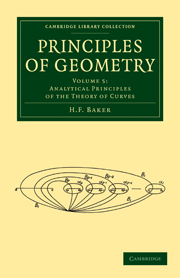Book contents
- Frontmatter
- PREFACE
- Contents
- CHAPTER I INTRODUCTORY ACCOUNT OF RATIONAL AND ELLIPTIC CURVES
- CHAPTER II THE ELIMINATION OF THE MULTIPLE POINTS OF A PLANE CURVE
- CHAPTER III THE BRANCHES OF AN ALGEBRAIC CURVE; THE ORDER OF A RATIONAL FUNCTION; ABEL'S THEOREM
- CHAPTER IV THE GENUS OF A CURVE. FUNDAMENTALS OF THE THEORY OF LINEAR SERIES
- CHAPTER V THE PERIODS OF ALGEBRAIC INTEGRALS. LOOPS IN A PLANE. RIEMANN SURFACES
- CHAPTER VI THE VARIOUS KINDS OF ALGEBRAIC INTEGRALS. RELATIONS AMONG PERIODS
- CHAPTER VII THE MODULAR EXPRESSION OF RATIONAL FUNCTIONS AND INTEGRALS
- CHAPTER VIII ENUMERATIVE PROPERTIES OF CURVES
- INDEX
CHAPTER II - THE ELIMINATION OF THE MULTIPLE POINTS OF A PLANE CURVE
Published online by Cambridge University Press: 05 July 2011
- Frontmatter
- PREFACE
- Contents
- CHAPTER I INTRODUCTORY ACCOUNT OF RATIONAL AND ELLIPTIC CURVES
- CHAPTER II THE ELIMINATION OF THE MULTIPLE POINTS OF A PLANE CURVE
- CHAPTER III THE BRANCHES OF AN ALGEBRAIC CURVE; THE ORDER OF A RATIONAL FUNCTION; ABEL'S THEOREM
- CHAPTER IV THE GENUS OF A CURVE. FUNDAMENTALS OF THE THEORY OF LINEAR SERIES
- CHAPTER V THE PERIODS OF ALGEBRAIC INTEGRALS. LOOPS IN A PLANE. RIEMANN SURFACES
- CHAPTER VI THE VARIOUS KINDS OF ALGEBRAIC INTEGRALS. RELATIONS AMONG PERIODS
- CHAPTER VII THE MODULAR EXPRESSION OF RATIONAL FUNCTIONS AND INTEGRALS
- CHAPTER VIII ENUMERATIVE PROPERTIES OF CURVES
- INDEX
Summary
As a large part of the difficulty of the theory of curves depends upon the possible intricacy of their multiple points, it seems desirable to shew at once, with the most elementary considerations, that any plane curve is in (1, 1) birational correspondence with a curve, in space of three or more dimensions, which is without multiple points. Some of the ideas involved have already been met with in Chap, 1; but the present chapter is designed to be complete in itself.
Consider a given plane curve f(x, y, z) = 0, of order µ, with any multiple points; the curve is supposed to be irreducible, that is, the polynomial f(x, y, z) cannot be written as the product of other polynomials also rational in x, y, z. A curve whose equation is of the form λ0φ0 + λ1φ1 + … + λr φr = 0, wherein φ0 = 0, …, φr = 0 are definite curves of the same order, which may have common points, upon f = 0, or elsewhere in the plane, determines, by its intersections with f = 0, a set of points thereon. Of these points, some may be the same for all values of the parametric coefficients λ0, …, λr , being common intersections with f = 0 of all the curves φ0 = 0, …, φr = 0; the others will, in general, vary when these coefficients vary.
- Type
- Chapter
- Information
- Principles of Geometry , pp. 24 - 34Publisher: Cambridge University PressPrint publication year: 2010First published in: 1933

